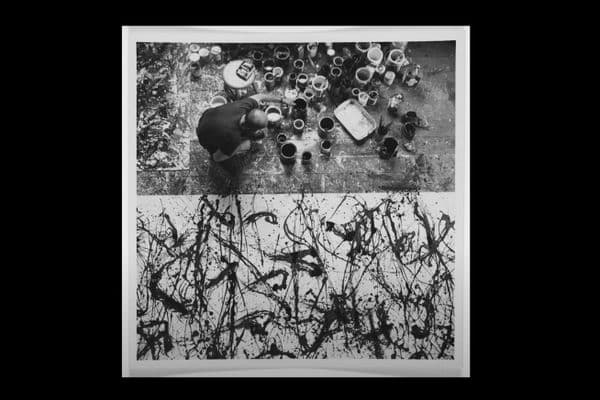Jackson Pollock's Blue poles
4 Oct 2002 – 27 Jan 2003

Jackson Pollock, Blue Poles, 1952, purchased 1973 © Pollock-Krasner Foundation. ARS/Copyright Agency
About
To celebrate the fiftieth anniversary of Jackson Pollock's Blue poles, the Gallery will mount an exhibition focused around this important painting. Presenting Pollock's work in its original artistic context, the exhibition will also document the responses his art has provoked in Australian art and the public arena.
exhibition Pamphlet essay
The abstract paintings of the American artist Jackson Pollock (1912–1956) are among the highest achievements of 20th-century art. During an unparalleled period of creativity from the late 1940s to the early 50s, Pollock abandoned the conventional tools and methods of the painter, putting aside brushes, artist’s paint and traditional composition, and poured and flung house paint directly onto large canvases placed on the floor. Inspired by the work of earlier modern artists that he admired such as Pablo Picasso and Joan Miró, Pollock’s painting has had an enormous impact on contemporary art up to the present day.
Pollock's life story is no less startling than his art. From humble beginnings in a family of Wyoming farmers, he struggled for years to overcome an apparent lack of natural talent before his rise to artistic stardom in the New York art world. Pollock’s fame – fuelled by articles in the popular press such as Life magazine which in 1949 posed the question ‘Is he the greatest living painter in the United States?’ – was followed by a slide into alcoholism and depression, and a concomitant decline in output. His death in a car accident at the age of 44 has prompted comparisons to other short-lived American icons, such as Charlie Parker and James Dean.
Within the life and work of this extraordinary artist, the National Gallery of Australia’s Blue Poles: Number 11, 1952 occupies a special place. Pollock’s last monumental abstract painting, Blue Poles is the final instalment in a series of works which have changed the course of modern art. The controversy, however, that followed the work’s purchase for 1.3 million Australian dollars – a record price at the time both here and in the United States – and the subsequent claims that the work began as a drunken collaboration between Pollock and other artists, have made it difficult to see the picture through the journalistic hype. The time is ripe for a re-evaluation of Blue Poles.
The focus exhibition Jackson Pollock’s Blue Poles, at the Gallery from 4 October 2002 until 27 January 2003, commemorates the painting’s 50th anniversary, and explores the meaning of Blue Poles by placing it within the broader development of the artist’s work. Paintings, drawings and prints by Pollock from the Gallery’s collection will be displayed alongside a selection of his works borrowed from American and European museums. Representing key moments in the artist’s career, the exhibition will trace the evolution of Pollock’s style from the early figurative work of the 1930s to the abstract ‘drip’ paintings of the 50s, leading to a fuller understanding of the genesis of Blue Poles.
The turning point in Pollock’s career was the mid-1940s. Two significant events occurred in 1945: his marriage to fellow artist Lee Krasner and their move to a house in the countryside in East Hampton. It was in the studio that they set up in the barn that Pollock first began pouring paint, either straight out of the can or with sticks and hardened brushes, directly onto a canvas placed on the floor. In an interview he justified his unusual method of painting by saying that ‘the modern painter cannot express this age, the airplane, the atom bomb, the radio, in the old forms of the Renaissance or of any other past culture’. [1] Pollock felt that his painting technique reflected not only the ‘inner world’ of the unconscious but also the cultural experience of the time he was living in. [2] Unexpectedly, to express these things, he felt compelled to move away from figurative art. As he remarked in 1949: ‘I try to stay away from any recognisable image; if it creeps in, I try to do away with it . . . to let the painting come through. I don't let the image carry the painting . . . It's extra cargo and unnecessary.’ [3] It was important that the meaning of the art work should not be carried by any recognisable image, as this was something extraneous to the medium of painting itself: ‘Experience of our age in terms of painting – not an illustration of but the equivalent: concentrated, fluid.’ [4] To express the modern age, painting would have to be equal to that age – not to illustrate it through an image but to participate in the intensity and fluidity of modern society through the very manner in which the painting was produced.
Although Pollock rejected many of the traditional methods of artistic control over his painting, preferring to pour, dribble, fling and pool paint onto the canvas, the effect is often staggering and incredibly beautiful. In the ‘classic’ pictures of the period 1947–50, such as One: Number 31, 1950 the black, white, brown, and blue-green arcs of flung paint on unprimed canvas seem to cartwheel before the viewer’s eyes in a majestic dance of colour. Neither a nihilistic statement nor a ‘paint pot flung in the public's face,’ Pollock used the effects of gravity, liquidity of materials, and the collisions between paint and canvas to show the viewer how oil paint behaves when it is pooled, what enamel looks like when it is thrown onto different kinds of surfaces – either dry paint, wet paint or unprimed canvas. Similarly, in his smaller scale enamel on paper works, such as Number 12, 1949 we are directly confronted by the vivid, shiny physicality of the enamel, as well as the extraordinary effects of puckering, marbling, puddling and interlacing of paint in all its raw beauty. In other words, he allowed the materials to speak their own language. As the traces of gravity, liquidity, and fortuitous occurrences appear to have taken place with a minimum intervention of the artist, the painting has what Pollock claimed it should: ‘a life of its own.’ [5]
At the same time, as the art historian Meyer Schapiro has pointed out, dripping is one of the painterly techniques of ‘handling, processing, surfacing, which confer to the utmost degree the aspect of the freely made’. [6] Pollock signalled through his liberated use of materials that he was free of constraints on his own individuality, artistic or societal. He was liberated to the extent of not entirely planning in advance what he was going to do.
His works were not based on preliminary studies: ‘I don’t work from drawings, I don’t make sketches and drawings and color sketches into a final painting.’ Moreover, as he commented ‘When I am in my painting, I’m not aware of what I’m doing. It is only after a sort of "get acquainted" period that I see what I have been about.’ [7] In other words, he freed himself from his own pre-conceptions of what would happen on the canvas, giving free rein to the physical body and its performance ‘in’ the painting. By working in large scale and by placing the canvas on the floor, Pollock allowed his full body movement to be engaged. We read the grand, sweeping lines of flung paint in One: Number 31, 1950 not as the result of a rationally driven, artistic ordering process but rather as evidence of the physical arc of the arm as it swings across the canvas. This focus on the physical, combined with the often-published photographs by Hans Namuth of the artist at work has been instrumental in the notion of Pollock as the ‘action painter’, an artist more concerned with the authenticity of the physical act of painting than with the measured consideration of the how the act should be performed.
Nevertheless, as Pollock himself insisted, he did carefully orchestrate his actions in such a way as to ‘deny the accident’. [8] The delicate tracings of splashed, dribbled and flowing pigment actually attest to the control that Pollock had over his materials, demonstrating that part of the artist's intention was to exploit accident while managing his performance with extraordinary dexterity. As Frank O’Hara once wrote about Pollock’s painting:
There has never been enough said about Pollock’s draftsmanship, that amazing ability to quicken a line by thinning it, to slow it by flooding, to elaborate that simplest of elements, the line – to change, to reinvigorate, to extend, to build up an embarrassment of riches in the mass by drawing alone. [9]
It is for this reason that the paintings are so compelling, because in Pollock’s work we have the feeling of order wrested out of disorder. Giving in to the nature of the materials and the forces of gravity, and giving free rein to the human desire to burst all constraints, Pollock’s paintings were able to embody a recurrent theme in contemporary America, that of modern man as ‘the helpless prey of forces both within and without himself’. At the same time, by exhibiting his technical finesse in the management of these forces, Pollock achieved a victory in the face of what could only seem impossible odds. [10]
Another important element of Pollock's technique is the 'all-over' composition. When we look at the classic paintings and our eye roves over the surface looking for some way of making sense of the picture, we realise that it is not easy to identify discrete areas of the canvas that can be differentiated visually. As the critic Clement Greenberg argued, the all-over composition, in which the traditional distinction between figure and ground is all but obliterated, responds to a modern feeling that ‘all hierarchical distinctions have been exhausted, that no area or order of experience is either intrinsically or relatively superior to any other’. [11] Rather than imposing hierarchy onto our experience of the painting, Pollock asks the viewer to choose his or her own points of interest. As Pollock insisted, the viewer ‘should not look for, but look passively – and try to receive what the painting has to offer’. [12] To look for, to bring a pre-conceived idea to the painting, would interfere with the experience of being in front of the work.
Crucial to understanding the 1952 painting Blue Poles is the knowledge that it is a late work in which Pollock re-assessed his drip style in the classic pictures of 1947–50. In many respects, the approach in Blue Poles is similar to his earlier works such as One: Number 31, 1950; the painting is built up with successive layers of dripped and poured paint evenly dispersed across the canvas. However, it also differs in a number of important respects, not least of which are the strong vertical elements of the ‘poles’. As the exhibition Jackson Pollock’s Blue Poles demonstrates, this departure was both a reprise of a recurrent motif in Pollock’s work and a self-conscious re-evaluation of the painting technique for which he was famous.
Anthony White











